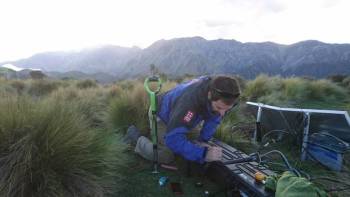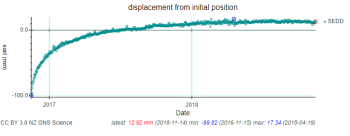
Kaikōura two years on: What’s changed in our field network since?
In the days following the Kaikōura quake our field technicians installed over 20 new instruments in the upper South Island to help us better locate the many aftershocks and see how the land was moving. What have we done since then?
To tell us how the land was behaving, field technicians installed nine temporary sites. Some of these sites were put up with a ‘use-what-you-have’ mentality, employing real Kiwi ingenuity.
Four such sites featured our famous Spade-Tenna (patent very much still pending) and were knocked together with whatever supplies were available on the helicopter. These Spade-Tennas provided height for the radio to better communicate with base and were a genius idea at the time. They have since been decommissioned as stations were upgraded.
“There weren’t a lot of instruments in that region prior to the quake, just our standard network”, says Tim McDougall, GeoNet Science Operations Specialist.
“We’ve since added several sites to monitor as much activity in the region as possible, which includes earthquakes and land movements.”
In the weeks and months following the quake, our GPS network detected widespread slow-slip and after-slip in Central New Zealand that was triggered by the quake.
“It was so important to our monitoring and research that our field technicians were able to install temporary sites in the days immediately after the earthquake”, says Elisabetta D’Anastasio, Geodetic Processing Specialist.
“With GPS we can monitor the land movement at a millimetre scale, so we need GPS sites to see how much things are moving, especially after an earthquake. Having the temporary sites in place very early on enabled us to get a better picture of which areas were affected by earthquakes and how. For example, GPS allowed us to detect the slow-slip events in the North Island triggered by the earthquake.”
The above chart, a displacement timeseries from a GPS site near Seddon, shows that the land has moved about 11cm from its initial position after the Kaikōura quake. If our technicians had waited a couple of months to get the site installed, we would have missed information about the initial curve (which indicates continued movement after the earthquake).
Our scientists recognised how important the information they were getting from these sites was, which is why several of them were upgraded to permanent sites. The permanent site upgrades included installing some strong motion sensors and weak motion seismographs.
You can access our network map here to see all the instruments we have nationwide. The sites installed post-Kaikōura are:
GLOK/GLOS
LOOK/LOKS
SEDD/SDNS
WRAU/WRAS
CLRR/CRSZ
TENN/TENS
Our field technicians also made some additions to other existing sites to send us more key information, such as strong motion data. The new and upgraded sites greatly bolstered our geohazard monitoring capability, so the three remaining temporary sites were decommissioned over the last year.
“We have ongoing plans to complete the upgrade of some of our instruments at existing sites in the north-east of the South Island. This will provide better overall network coverage and enable a more accurate location of earthquakes here in the future,” Tim McDougall explains.
In the 17 years since GeoNet was established, the real-time instrument network has flourished from 30 to over 600 stations nationwide. This has allowed us to continually improve the accuracy and completeness of our earthquake catalogue over time.
This update on our network has been the last in a five-part series marking the two-year anniversary of the Kaikōura quake. You can read our other articles here:
Kaikōura two years on: The changed landscape
Kaikōura two years on: Playing the long game with landslides

